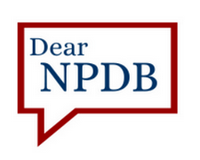NPDB Insights - February 2022

Is It Reportable?
A state licensing board is required to report any publicly available negative actions or findings. If a state licensing board does not publish its actions on the board's website, but publishes them in a publicly available monthly newsletter, does the board still have to report the actions to the NPDB?
Yes. Publicly available information means that information is accessible to the interested public and can occur in a variety of ways, including, but not limited to, phone, writing, electronic media (e.g., website or portal), or other media available for general distribution to any member of the public.

How To Change Your Organization's Information With the NPDB
There are two basic types of changes that Data Bank Administrators can make to their organization's NPDB registration. You can update your profile information or you can change the status of your registration.
Update Your Profile
Updating your profile allows you to make changes to any of your organization's registration information, including:
- Payment, notification, and agent-health care organization relationship preferences
- Points of contact
- Organization name
Your Data Bank administrator must complete the following steps to update your organization's profile information:
- Sign in to the NPDB and click Continue.
- On the Administrator Options page, select the link for the type of change you want to make (e.g., update registration profile, maintain user accounts, maintain credit cards or authorize EFT, maintain entity-agent relationships, etc.).
In addition to maintaining contact information in the organization's profile, the Data Bank Administrator is also responsible for adding, changing, and deleting user accounts for each individual at the organization. User contact information should be kept up-to-date, and users must be deactivated if they are no longer with the organization, or if their job no longer requires them to have access to the NPDB.
Visit the How to Update Profile Information page for an explanation of each option.
Change Your Status
If your organization no longer needs an NPDB account, you must deactivate your registration. If your organization was acquired by or merged with another organization that is registered with the NPDB, you may designate that organization as a successor for your organization. This allows you to transfer your organization's NPDB records to the successor.
For more information on how to deactivate your DBID or designate a successor organization, contact our Customer Service Center.

Dear NPDB
May I share my organization's query response?
It depends. The confidentiality provisions of Title IV, Section 1921, and Section 1128E allow eligible entities receiving information from the NPDB to disclose the information to others who are part of the investigation or peer review process, as long as the information is used for the purpose for which it was provided. Sharing a practitioner's query with an individual or organization that is not part of the entity's credentialing, investigating, or peer review peer process violates the confidentiality provisions of the NPDB.
Health systems composed of multiple health care entities (e.g., several hospitals, outpatient surgery centers, and clinics) frequently have practitioners providing health care services at more than one of their health care entities. If a health care system conducts its credentialing centrally, has a centralized peer review process, and has one decision-making body, the health care system may query the NPDB only once on each practitioner during the professional review process, regardless of whether the practitioner provides health care services in one or multiple entities. In these instances, query responses can be shared between entities within the same health care system.
However, if the system's health care entities conduct their own credentialing, and each health care entity grants privileges to provide health care services only in its facility, each health care entity must query the NPDB separately on its own practitioners. In these instances, sharing query responses between health care entities is prohibited.
For more information, see our How Many Queries Do I Need to Run? infographic.
You may share the results of a query response with the subject of the query as long as all of your entity information is redacted from the response (i.e., your organization's name, Data Bank ID Number, Document Control Number, etc.).
The latest updates and resources are available at https://www.npdb.hrsa.gov.
Previous editions of NPDB Insights are available in our archive.
 An official website of the United States government.
An official website of the United States government.

